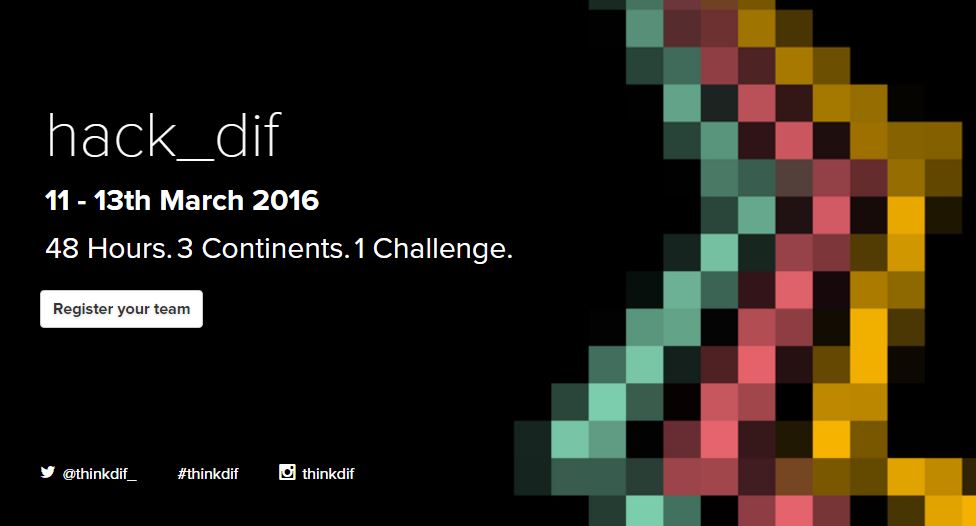Make smart connected products better for our future circular economy
10/02/2016

Do you have ideas to help make the things we use work better for us and help the environment? Could you make them a reality with the help of an international team located on three continents in just 2 days? This is the task we’re setting ourselves at hack_dif on 11-13 March 2016.
With support of the Ellen MacArthur Foundation, Cisco and Philips, we will be setting up for a hackathon weekend at Cranfield University, and working remotely with innovative collaborators at MIT in Massachusetts in the United States, and at the National Institute of Design in Gujarat in India. After just 48-hours we will be presenting workable solutions, which could contribute to a circular economy (one that makes the most of our resources rather than squandering them). And, you can be a part of this epic challenge too – as long as you can join us in person in the UK, USA or India! (If you want to take part – register online here).
Teams made up of hackers, thinkers, doers, designers, pragmatists, visionaries, tech-heads and creatives will come together to consider the future of ‘connected products’. This simply means any ‘smart’ technology like smart TVs or other home appliances that connect to the internet. It isn’t just consumer goods like toasters and fridges; it might also be a whole company’s production line or air conditioning.
The market for smart and connected products is worth millions worldwide. As we become more used to the benefits of connecting everything to the web, the sector is expected to grow. But are these millions of products destined to end up in landfill? We already know electronics contain expensive components and metals in their circuitry, and that landfill waste has the potential to pollute land for decades to come.
So, at hack_dif we’re going to find a solution. We’re asking the best minds to come together and consider whether we could use the same smart capabilities of these products to extend their useful life – for example through preventative maintenance or remote repair. Teams might also consider how we use technology to ensure products are used in the best way – reducing wear on certain parts for example to prevent single point failures, or a ‘sharing economy’ that allows users access to a product when they need it rather than gathering dust. And, solutions might also consider what happens when a product really is at the end of the line. How does a product get back to a manufacturer to be recycled or remanufactured? All of these considerations could help us get closer to a circular economy model.
What will we come up with? Who knows! We’ll share the process and the products on this blog after the hackathon is complete.
Categories & Tags:
Leave a comment on this post:
You might also like…
Keren Tuv: My Cranfield experience studying Renewable Energy
Hello, my name is Keren, I am from London, UK, and I am studying Renewable Energy MSc. My journey to discovering Cranfield University began when I first decided to return to academia to pursue ...
3D Metal Manufacturing in space: A look into the future
David Rico Sierra, Research Fellow in Additive Manufacturing, was recently involved in an exciting project to manufacture parts using 3D printers in space. Here he reflects on his time working with Airbus in Toulouse… ...
A Legacy of Courage: From India to Britain, Three Generations Find Their Home
My story begins with my grandfather, who plucked up the courage to travel aboard at the age of 22 and start a new life in the UK. I don’t think he would have thought that ...
Cranfield to JLR: mastering mechatronics for a dream career
My name is Jerin Tom, and in 2023 I graduated from Cranfield with an MSc in Automotive Mechatronics. Originally from India, I've always been fascinated by the world of automobiles. Why Cranfield and the ...
Bringing the vision of advanced air mobility closer to reality
Experts at Cranfield University led by Professor Antonios Tsourdos, Head of the Autonomous and Cyber-Physical Systems Centre, are part of the Air Mobility Ecosystem Consortium (AMEC), which aims to demonstrate the commercial and operational ...
Using grey literature in your research: A short guide
As you research and write your thesis, you might come across, or be looking for, ‘grey literature’. This is quite simply material that is either unpublished, or published but not in a commercial form. Types ...






